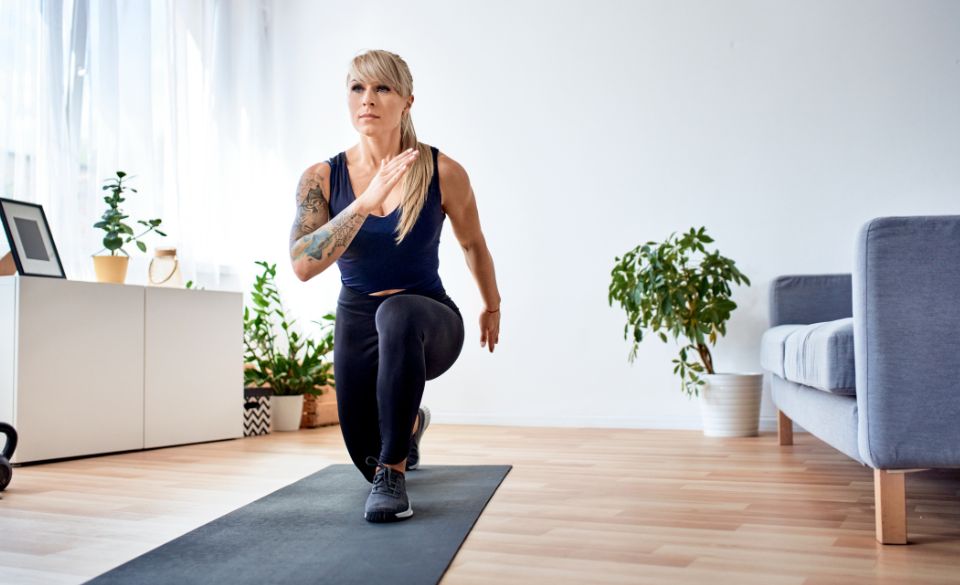
How to Do a Lunge: Mastering the Ultimate Lower Body Exercise
Page Contents
Lunges are a fantastic exercise for building strength and tone in your lower body. They target multiple muscle groups, including the quadriceps, hamstrings, glutes, and calves, making them a versatile and effective movement. Whether you’re a fitness enthusiast or just starting your fitness journey, incorporating lunges into your routine can yield impressive results. In this blog post, we will guide you through the proper form and technique of performing a lunge, ensuring you maximize its benefits.
Understanding the Proper Form
Before delving into the various lunge variations and benefits, it’s crucial to understand the correct form. Proper form not only helps you avoid injury but also ensures that you engage the targeted muscles effectively.
To perform a lunge correctly, follow these steps:
1. Stand tall with your feet hip-width apart and your shoulders relaxed.
2. Take a step forward with your right foot, ensuring that your knee is directly above your ankle, forming a 90-degree angle.
3. Lower your body by bending both knees, keeping your weight on your front heel.
4. Pause for a moment, then push through your front heel to return to the starting position.
5. Repeat on the opposite side, alternating legs for each repetition.
Exploring Different Lunge Variations
Once you’ve mastered the basic lunge, you can experiment with various lunge variations to challenge your muscles further and prevent workout monotony. Here are a few popular lunge variations you can try:
1.Reverse Lunge: Instead of stepping forward, step backward with one leg, maintaining the same form as a regular lunge. This variation engages your hamstrings and glutes to a greater extent.
2. Walking Lunge: This variation involves taking steps forward while performing lunges with each step. It adds a dynamic element to the exercise and improves balance and coordination.
3. Side Lunge: Begin with your feet hip-width apart, then take a wide step to the right and bend your right knee, while keeping your left leg straight. Return to the starting position and repeat on the other side. Side lunges primarily target the inner and outer thighs.
The Benefits of Lunges
Now that you have a solid understanding of how to perform lunges correctly and some variations to spice up your routine, let’s explore the remarkable benefits of incorporating lunges into your fitness regimen:
1. Strengthens Lower Body Muscles: Lunges target multiple muscles simultaneously, including the quadriceps, hamstrings, glutes, and calves. By consistently performing lunges, you can build lean muscle mass and improve lower body strength.
2. Enhances Functional Movement: Lunges mimic everyday movements like walking, climbing stairs, or bending down to pick something up. By incorporating lunges into your workout routine, you improve your overall functional fitness and make everyday activities easier.
3. Improves Balance and Stability: Lunges require stability and balance to maintain proper form throughout the exercise. Regularly practicing lunges can enhance your balance and stability, reducing the risk of falls and injuries in daily life.
Tips for Effective Lunges
To make the most of your lunge workouts, consider the following tips:
1. Maintain Proper Alignment: Keep your upper body straight, shoulders relaxed, and core engaged throughout the exercise. Avoid leaning forward or allowing your knee to extend beyond your toes.
2. Start with Bodyweight: If you’re new to lunges, begin with bodyweight lunges before adding weights or resistance. This allows you to focus on form and gradually build strength.
3. Progress Gradually: As you become more comfortable with lunges, you can progress and challenge yourself by adding weights such as dumbbells or a barbell. Start with lighter weights and gradually increase the load as you get stronger and more confident in your form.
4. Engage Your Core: To maximize the benefits of lunges and maintain stability, remember to engage your core muscles. This will not only help you maintain proper alignment but also strengthen your core muscles.
5. Breathe Properly: It’s essential to maintain a steady breathing pattern while performing lunges. Inhale as you lower your body and exhale as you push back up to the starting position. This rhythmic breathing will help you maintain focus and provide oxygen to your muscles.
Remember, like any exercise, it’s important to listen to your body and work within your limits. If you experience any pain or discomfort during lunges, consult a fitness professional or healthcare provider.
Studies Supporting the Effectiveness of Lunges
While the effectiveness of lunges may seem evident from personal experience, several studies have also supported their benefits. Let’s take a look at some scientific findings that highlight the effectiveness of lunges:
A study published in the Journal of Strength and Conditioning Research found that lunges effectively activate the quadriceps, hamstrings, and gluteal muscles. The researchers concluded that lunges are a valuable exercise for lower body strength development.
Another study published in the European Journal of Applied Physiology examined the muscle activation patterns during various lower body exercises, including lunges. The results showed that lunges produced high levels of muscle activation in the quadriceps and gluteal muscles, making them an excellent choice for targeting these muscle groups.
A research study published in the Journal of Sports Science & Medicine compared the muscle activation between forward lunges and rear lunges. The findings revealed that both variations activated the quadriceps and hamstrings to a similar extent, while the gluteus maximus was more activated in the rear lunge. This suggests that incorporating different lunge variations can provide a well-rounded lower body workout.
Additionally, a study published in the Journal of Physical Therapy Science investigated the effects of a 12-week lunge exercise program on muscle strength and balance in older adults. The results showed significant improvements in lower body muscle strength, balance, and functional mobility. This highlights the potential benefits of lunges for individuals of all age groups.
These studies provide scientific evidence supporting the effectiveness of lunges in targeting specific muscle groups, improving strength, and enhancing functional movement. Incorporating lunges into your fitness routine can contribute to overall lower body development and functional fitness.
So, don’t underestimate the power of lunges! With proper form, varied variations, and consistency, lunges can be a game-changer in your fitness journey.
Remember, it’s always a good idea to consult with a qualified fitness professional to ensure that you are performing exercises correctly and to tailor a workout plan to your individual needs and goals.



